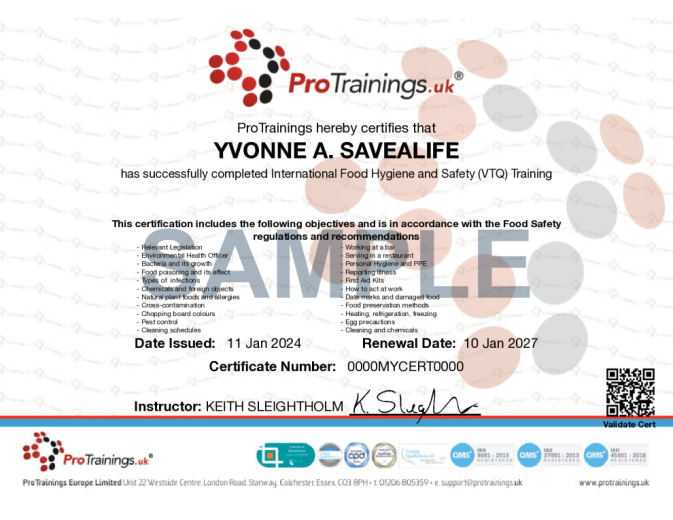- Food Hygiene Legislation
- Relevant Legislation
- The Environmental Health Officer
- HACCP
- Training for people in food handling
- Food Hygiene ratings
- Bacteriology and Food Poisoning
- What are bacteria and how do they grow and affect us
- How we control their growth
- Food poisoning and its effect
- Symptoms of food poisoning
- Types of infections
- Chemicals and foreign objects
- Natural plant foods and allergies
- Hazards of chemicals near food
- Listeria and keeping food safe
- Campylobacter
- Food Contamination
- Cross-contamination
- The danger zone
- Ways of preventing cross-contamination
- Chopping board colours
- High-risk foods
- Pest control
- Fly control
- Hot food display units
- Working at a bar
- Serving in a restaurant
- Bars and restaurants
- Restaurant workers
- Personal Hygiene
- Hand washing and hand gels
- Protective clothing
- Reporting Illness
- First Aid Kits for food preparation
- How you need to act at work
- Personal Illness and exclusion from work
- Personal illness, employee's, responsibilities
- Food storage and Preservation
- Food area requirements
- Rules on keeping your water supply safe
- Heating and refrigeration
- Refrigeration and freezing
- Dietary Requirements
- Gluten-free Foods and Coeliac disease
- Egg precautions
- Use by and Best before dates for effective stock control
Understand how individuals can take personal responsibility for food safety
1.1 Outline the importance of food safety procedures, risk assessment, safe food handling and behaviour
1.2 Describe how to report food safety hazards.
1.3 Outline the legal responsibilities of food handlers and food business operators
Understand the importance of keeping him/herself clean and hygienic
2.1 Explain the importance of personal hygiene in food safety including its role in reducing the risk of contamination
2.2 Describe effective personal hygiene practices, for example, protective clothing, hand washing, personal illnesses, cuts and wounds
Understand the importance of keeping the work areas clean and hygienic
3.1 Explain how to keep the work area and equipment clean and tidy to include cleaning and disinfection methods, safe use and storage of cleaning chemicals and materials, and waste disposal
3.2 State how workflow, work surfaces and equipment can reduce contamination risks and aid cleaning
3.3 Outline the importance of pest control
Understand the importance of keeping food safe
4.1 State the sources and risks to food safety from contamination and cross-contamination to include microbial, chemical, physical and allergenic hazards
4.2 Explain how to deal with food spoilage including recognition, reporting and disposal
4.3 Describe safe food handling practices and procedures for storing, preparing, cooking, chilling, reheating, holding, serving and transporting food
4.4 Explain the importance of temperature controls when storing, preparing, cooking, chilling, reheating, holding, serving and transporting food
4.5 Describe stock control procedures including deliveries, storage, date marking and stock rotation








